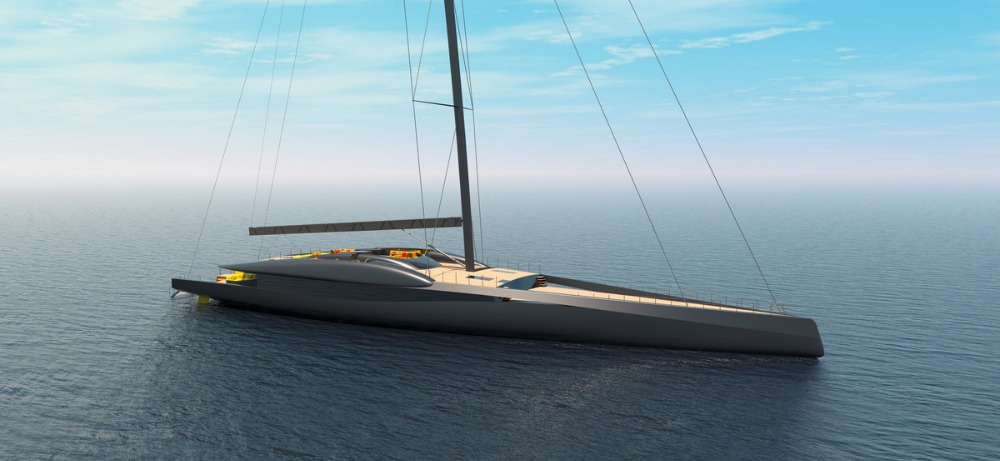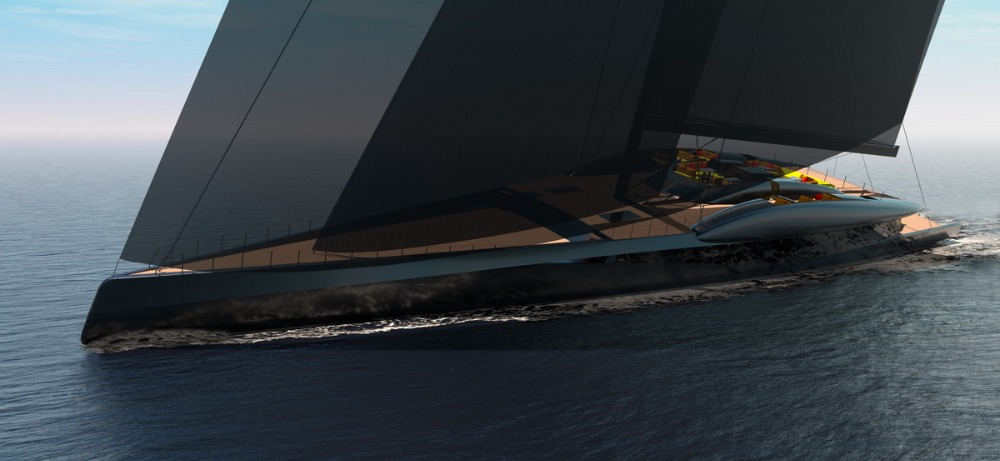Project Fury gives it back
Why are we scared of the beam anyway? …
The traditional design for large sailing yachts includes a fairly set ratio of gross tonnage/usable interior volume related to LOA and displacement. Project Fury, a 63m concept from Rob Doyle Design and Van Geest Design, aims to break out from this norm. A full link to the highly detailed press release can be found here.
The core of the design, and what elevates it to potentially groundbreaking, is space. Design convention would dictate that a 63m single hull sailing superyacht would have around 500GT; Doyle and van Geest hope to push this to 705GT, a 40 per cent gain in space that many large sailing yachts certainly need. SuperyachtNews speaks to both Doyle and van Geest to determine how they got there, why others may not have and what it may mean for the owner experience onboard.
“It's likely the most expensive piece of real estate they'll ever buy; where possible, we might as well give them every square centimetre back we can.”
Outliners aside, there is relative stability of styling in the large sailing yacht fleet. As Doyle stresses, "We've gone very safe, not safe as in health and safety, safe as in design". There are imperatives that guide naval architecture, and nowhere more so than sailing yachts. The beam and the associated gross tonnage considerations for sailing yachts is one such imperative... unless it isn’t quite that clear cut? as Doyle elaborates, “The industry is scared of the beam, and a lot of designers don't know where the beam constraints came from, and they are afraid to go away from the conventional designs. Once again, we revert to the safe styling.”
As the name implies, there are three axes to three-dimensional space, and on a yacht, being able to increase the width is the one spatial dimension that has retained a strict upper limitation. “The idea we came up with was to create a wider beam hull and get rid of the side decks. I said to Pieter; knock yourself out here, let's go crazy with the interior volume I'm giving you. In the first image he sent us, he thought he went too far. And I said, no, no, go for it!”
Van Geest is also quick to highlight the fact that there are other sailing superyacht design conventions that may not be safe from a re-evaluated design future. “Why the side decks? They are connected to sailing, but do we always need them? What happens if we take them away and you give the whole width of the boat to the interior.” This gift to the interior has a fairly sizeable impact. The full-beam main salon and master cabin have been calculated at 130m² and 95m², respectfully.
But if it's that easy to extend the beam, why do we still see such continuity in design? Doyle has a theory; “The biggest constraint to the beam was always right of moment, and so we had to narrow the boats because we couldn't get rigging strong enough. As soon as carbon rigging entered the market, that constraint disappeared. A lot of designers cut and paste because sometimes they don't know their naval architecture history.”
With an extended beam and removing the side decks, Project Fury can theoretically dedicate more space to the owner and guests. The inclusion of captive winches and a contained central bridge and outboard helm stations creates a potentially safer environment for the guests while giving the crew room to operate. After recalling his racing experience, Doyle voiced his frustration that many owners do not experience the full excitement of a high-performance superyacht.“ We end up in a situation where professional sailors are onboard telling the owner, who's just spent a fortune building the boat of their dreams, only then to be told to sit in your place and don't come past these tape lines on the deck.” This consideration seems to have guided much of the design.
At first design impressions, the forward visibility looks fantastic. The decision not to have a large tender garage aft provides significant space for a rear transom and swim platform but will rely on a chase boat if the guests would like anything larger than the two seven-metre RIBs currently factored in. The most intriguing and striking feature is undoubtedly the ‘pods’ flanking the sky deck and housing the helm stations. While they may not suit every taste, it is undeniable that they give a vast amount of space across the remainder of the Skydeck over the guests. As stressed by Doyle, that is vital to the philosophy that underpins the design. “it's about making sure owners, and guests can experience what we as crew get out of it, we're trying to give them that feeling that we get from sailing fast and translating it to people who are new to superyacht regattas and new cruising itself. It's not all heel angles and inconveniences; we want them to feel the excitement of a race.”
While not explicitly specified, Doyle informed me that the rig would be past Panamax and around 80m, and with the length of boom and sail type, the surface area will certainly be immense. After consultation with crew on previous projects, the decision has been made that Project Fury will have slab reefing, which Doyle sees as having multiple additional benefits. " We see a return to slab reefing, which is a lot safer and easier. And there's a huge cost saving as well, which is money that can be spent elsewhere."
The freedom to try to break the mould while meeting an owner's expectations is a balancing act, as Doyle points out. “You don't necessarily need the owner involved at the first stage to be able to get the best out of us as designers. They can tell us what they like and don't like, and we can work with that, but just getting the concept on the piece of paper, you have just got to leave us alone and let us go a little mad…with a touch of reality of course.”
With an eye on a zero-emissions future, Doyle also highlights that the technology is already in place to support their designs. "The vessels we are designing now, we can do a full transatlantic crossing on full hotel load power requirements without burning any hydrocarbons", and with the pace of development in this area, there is no barrier to the scalability of the zero-emissions sailing design to Project Fury and beyond. As Doyle concluded, "We are just waiting for the right visionary owner."
According to van Geest, interest has been keen, and there is already plans to extend the design up to 2200GT in the future, which would mark a quantum leap in the usable space of a high-performance sailing superyacht.
NEW: Sign up for SuperyachtNewsweek!
Get the latest weekly news, in-depth reports, intelligence, and strategic insights, delivered directly from The Superyacht Group's editors and market analysts.
Stay at the forefront of the superyacht industry with SuperyachtNewsweek
Click here to become part of The Superyacht Group community, and join us in our mission to make this industry accessible to all, and prosperous for the long-term. We are offering access to the superyacht industry’s most comprehensive and longstanding archive of business-critical information, as well as a comprehensive, real-time superyacht fleet database, for just £10 per month, because we are One Industry with One Mission. Sign up here.
Related news
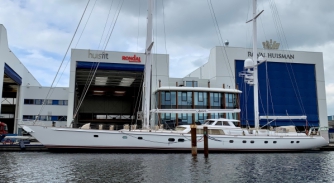
S/Y Juliet undergoes hybrid conversion
Under sail, electrical power will be generated by the rotation of the propeller
Fleet
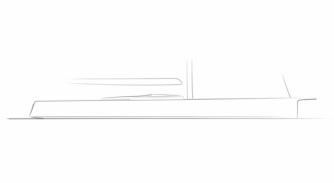
Baltic Yachts announces sale of Baltic 110
Due for delivery in 2023, the project comes at a busy time for the builder
Fleet

Baltic Yachts announces sale of Baltic 111 Custom
The new yacht is an extremely weight-sensitive project
Fleet
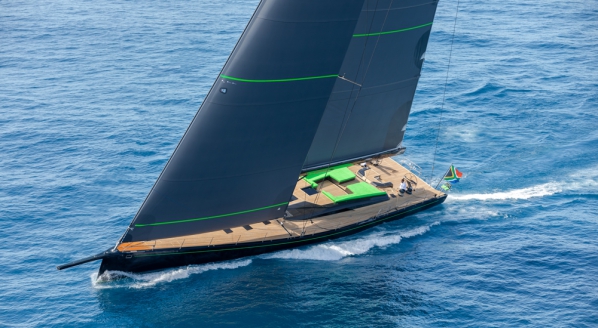
30m Southern Wind Morgana delivered
The Reichel/Pugh-Nauta 100 has arrived in the Mediterranean
Fleet
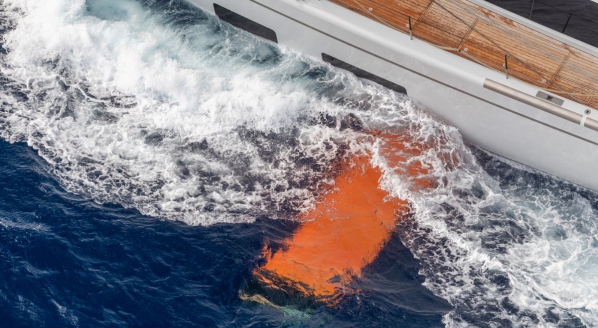
The future of sailing
Gordon Kay of Infiniti Yachts explains how delving into history can sometimes offer a glimpse into the future
Technology
Related news
S/Y Juliet undergoes hybrid conversion
5 years ago
Baltic Yachts announces sale of Baltic 110
5 years ago
30m Southern Wind Morgana delivered
5 years ago
The future of sailing
5 years ago
NEW: Sign up for
SuperyachtNewsweek!
Get the latest weekly news, in-depth reports, intelligence, and strategic insights, delivered directly from The Superyacht Group's editors and market analysts.
Stay at the forefront of the superyacht industry with SuperyachtNewsweek


